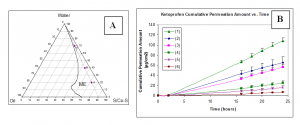Microemulsions for Transdermal and Topical Drug Delivery
For drug delivery, microemulsions offer several advantages including (1) significantly increasing drug solubility, (2) providing long-term formulation stability, (3) easy preparation, and (4) improving bioavailability for both lipophilic and hydrophilic drugs. Microemulsion internal structural domains are in the micro/nano-scale, typically in the range of 10 – 200 nm. For transdermal and topical drug delivery applications, microemulsions have demonstrated effectiveness in enhancing drug skin permeation and/or skin drug deposition. However, a microemulsion is a complex system and thus far, it is still not well understood what the mechanisms are which control microemulsion formulation enhancement of drug permeation.
The objective of our research is to investigate microemulsion microstructures and the relationship to drug skin permeation, key formulation factors, and the mechanism of skin permeation and deposition enhancement effects. In the study, based on successful microstructure characterization results, microemulsions with specific microstructures were prepared and used to conduct in vitro skin permeation experiments for both hydrophilic and lipophilic drugs. The results show that the water content is the one key factor in formulation. Drug permeation increases with water content, and thus, correlates with the microstructure change from w/o to bi-continuous, and to o/w. The degree of permeation enhancement with increasing water content is more pronounced for lipophilic model drugs. The other identified factor is the oil content, demonstrated by increasing permeation with increasing oil content in the formulation. Permeation enhancers, Azone and bromo-iminosulfurance can be easily incorporated into the microemulsion formulations, and their permeation enhancement effects were found to be model drug specific. Additionally, effective techniques were developed to characterize the microemulsion microstructure. Topical drug delivery enhancement effects using varied microemulsion microstructures continue to be studied.
